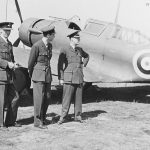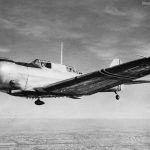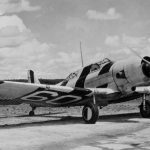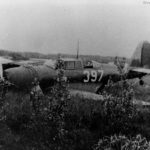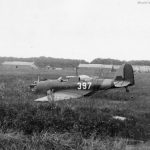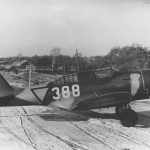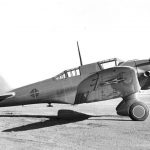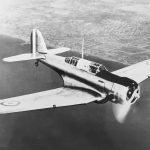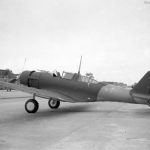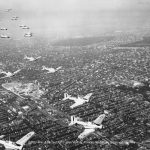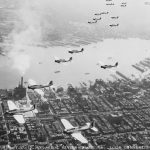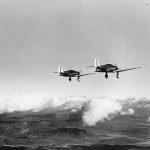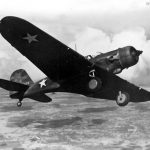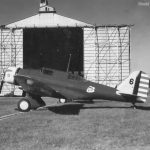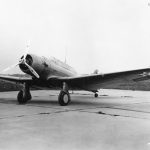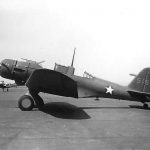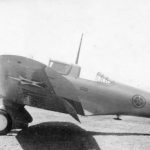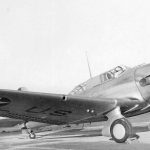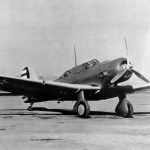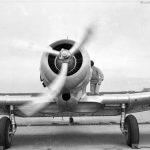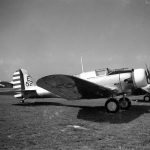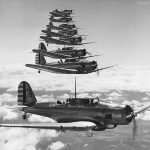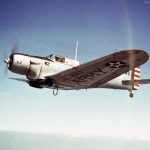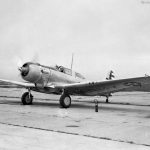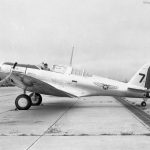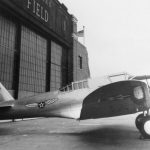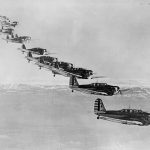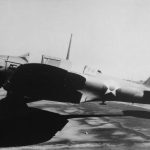Nomad Mk I
Norwegian Douglas 8A-5
Northrop Nomad as target tug
Douglas 8A-3N “397”
Light bomber Douglas DB-8A 397 of Luchtvaartafdeeling
Douglas DB-8A-3N 388
A-17 of 4th Air Base Squadron
Peruvian Douglas 8A-3P on a test flight off the coast near Los Angeles
A-17A May 1938
A-17 Formation 3rd Attack Group, 21 September 1937
A-17A formation of the 3rd Attack Group, 21 September 1937
A-17 in flight
A-17 1942
A-17 6
A-17 4
A-17 35-157
A-17 3
A-17 2
A-17 1941
A-17 1940
A-17 1936
A-17A
A-17A E52 of the 90th Attack Squadron September
A-17A formation from 17th Attack Group 1939
A-17A 62
A-17A 36-185 of the GHQAF
A-17A 36-185 of the GHQAF
A-17A 36-185
A-17A 17th AG
A-17A
History
The Northrop Gamma 2F was the ground attack version of the Northrop Gamma transport aircraft. Developed in parallel with the Northrop Gamma 2C programme, which gave rise to the YA-13 and XA-16, the Gamma 2F had a redesigned vertical stabilizer, cockpit and flaps compared to the Gamma 2C, in addition to a new semi-retractable landing gear and a bomb bay capable of holding 20 13.6 kg cluster bombs. The prototype was delivered for testing to the USAAC on 6 October 1934.
Although the evaluation was largely positive, the US Army requested some modifications, particularly in the aerodynamics. The 2F returned to the factory to undergo the requested adjustments. As the new landing gear had provided only a slight improvement in performance, it was replaced by a conventional but streamlined undercarriage. In addition, all the lines of the aircraft (fuselage and vertical stabilizer) were softened for better aerodynamics, the canopy was also reworked with the addition of an unglazed part between the pilot and the gunner.
On 24 December 1934, the USAAC announced its intention to purchase 110 Gamma 2Fs, under the official designation Northrop A-17.
Although the A-17 had good performance and was well armed, its main commercial attraction was its very attractive price of $19,000 each (without military equipment). This was very attractive at a time when America was struggling with the Great Depression. The contract was officially signed on 1 March 1935, the largest pre-war contract in the army and a real boon to the new branch of Northrop.
Initially it was planned to install large engines such as the R-1820 Cyclone or R-1830-7 Wasp for the production models, as had been decided on the Northrop YA-13. However, the YA-13 proved to be overpowered with the R-1830-7, and furthermore in order to prevent any supply shortages, it was decided to equip the production A-17 with the small R-1535.
The first Gamma 2F was delivered on July 27, 1935, as the official A-17 (serial number 35-51), modified to meet USAAC requirements. The remaining 109 A-17s (35-52 to 35-160) were delivered between December 1935 and January 1937. They were equipped with the 750 hp R-1535-11 engine. They differed from the prototype in that they were equipped with three perforated airbrake segments per wing. In addition, the ventral rear firing system, present on the prototype, was removed from the production model.
Although the evaluation was largely positive, the US Army requested some modifications, particularly in the aerodynamics. The 2F returned to the factory to undergo the requested adjustments. As the new landing gear had provided only a slight improvement in performance, it was replaced by a conventional but streamlined undercarriage. In addition, all the lines of the aircraft (fuselage and vertical stabilizer) were softened for better aerodynamics, the canopy was also reworked with the addition of an unglazed part between the pilot and the gunner.
On 24 December 1934, the USAAC announced its intention to purchase 110 Gamma 2Fs, under the official designation Northrop A-17.
Although the A-17 had good performance and was well armed, its main commercial attraction was its very attractive price of $19,000 each (without military equipment). This was very attractive at a time when America was struggling with the Great Depression. The contract was officially signed on 1 March 1935, the largest pre-war contract in the army and a real boon to the new branch of Northrop.
Initially it was planned to install large engines such as the R-1820 Cyclone or R-1830-7 Wasp for the production models, as had been decided on the Northrop YA-13. However, the YA-13 proved to be overpowered with the R-1830-7, and furthermore in order to prevent any supply shortages, it was decided to equip the production A-17 with the small R-1535.
The first Gamma 2F was delivered on July 27, 1935, as the official A-17 (serial number 35-51), modified to meet USAAC requirements. The remaining 109 A-17s (35-52 to 35-160) were delivered between December 1935 and January 1937. They were equipped with the 750 hp R-1535-11 engine. They differed from the prototype in that they were equipped with three perforated airbrake segments per wing. In addition, the ventral rear firing system, present on the prototype, was removed from the production model.
Northrop developed a variant, the A-17A, with a new fully retractable landing gear this time. This retractable landing gear was first examined on the Gamma 2J, a prototype trainer aircraft. The A-17 design proved to be easily adaptable to retractable landing gear, with relatively few changes required. However, the use of this equipment required the wing roots to be enlarged to provide space for the wheels.
The A-17A was equipped with an 825hp R-1535-13 Twin Wasp Junior engine. Its offensive and defensive armament was the same as the A-17, i.e. five .30 calibre (7.62 mm) machine guns and a total of 544 kg of bombs (20 x 13.6 kg anti-personnel bombs in the fuselage) and four 45 kg bombs under the wings.
On 29 January 1936, the USAAC placed an order for 100 aircraft (serial numbers 36-162 to 36-261). The first production A-17A (36-162) flew for the first time on 16 July 1936. The A-17A had some problems with the landing gear, which delayed the delivery of the other aircraft until 4 February 1937. During this period, the aircraft was used for testing. Two accidents caused by landing gear faults caused a further delay to the second production aircraft until April 1937. Once these problems were solved, the 100 A-17As were delivered to the USAAC between April and December 1937. A new order for 29 additional aircraft (38-327 to 38-355) was placed in the second half of 1937, which were delivered between June and September 1938.
A-17AS was an unarmed three-seat version of the A-17A, designed for personnel transport. The ‘S’ in the official designation stands for ‘Staff’ or ‘Special’. Two examples were ordered on 20 March 1936. Although their manufacturer’s serial numbers 289 and 290 follow the nomenclature of the first A-17A delivery, they were built and delivered much earlier.
The first A-17AS (36-349) was powered by a Pratt & Whitney R-1340-41, 9-cylinder air-cooled radial with 600 hp driving a three-blade propeller. It was delivered on 17 July 1936. It served as a personal transport aircraft for Maj. Gen. Oscar Westover. General Westover was the head of the Army Air Corps, and he personally flew the aircraft for nearly two years on inspection and manoeuvre supervision flights. On 21 September 1938, the aircraft crashed in Burbank, California, killing General Westover and his mechanic, S/Sgt Sameul Hymes.
The second A-17AS (36-350) was assigned to transport Brigadier General Henry H. Arnold. The Brigadier General succeeded General Westover on his death. General Arnold was thus appointed as his replacement as head of the Air Corp and remained in that position throughout the Second World War. This second aircraft was equipped with a 600 hp R-1340-45 radial engine driving a two-blade propeller. The 36-350 was lost in an accident on 2 March 1940.
The first production A-17 (35-52) was sent to Wright Field in December 1935, after being initially evaluated by the Technical Training Command at Chanute Field, Illinois. In early February 1936, the A-17s entered service with the 3rd Attack Group (to equip the 8th, 13th and 90th Squadrons) based at Barksdale Field, Louisiana. But they also equipped the 17th Attack Group (34th, 37th, and 95th Squadrons) based at March Field (California) which had recently been equipped with Boeing P-26 Peashooters.
That same year, the A-17s in two USAAC groups were supplemented by the A-17A retractable gear version. Shortly thereafter, the A-17s were retired from active service and transferred to training units.
USAAC decided that twin-engine aircraft had a greater advantage for attack mission than single-engine aircraft and the life expectancy of the A-17A in active service soon declined. After a brief three-year service with the USAAC, the A-17A was retired.
By the time of the attack on Pearl Harbor, the A-17 was totally obsolete, and the survivors ended their careers either as training aircraft or at the Aircraft mechanics’ school at Roosevelt Field, New York. Last American A-17A was finally scrapped on 31 October 1944.
A-17 serial number 35-122, was used by the National Advisory Committee for Aeronautics (NACA) for testing of laminar wing structures. New highly polished surfaces on and around the existing wing structure, extending beyond the leading and trailing edges to double the thickness of the wing. A two-bladed propeller driven by a small auxiliary motor was fitted to the new leading edge of each wing to increase the airflow speed on the upper surface. However, it was found that it was easier to obtain the same data using conventional wind tunnels. The NACA therefore abandoned the project.
A-17A 36-184 was used in 1939 by the National Advisory Committee for Aeronautics (NACA) to test new engine fairing designs. At the beginning of the tests, this A-17A was equipped with a large propeller pan that covered the engine air intakes, which were replaced by air intakes at the wing roots to cool the engine. However, before flight testing, ground tests indicated that the engine was not sufficiently cooled. The NACA abandoned plans for flight testing in this configuration. NACA removed the air intakes from the wings, and replaced the large propeller spinner with a smaller one, which had a large hole in the centre with a fan of some kind to force air to cool the engine. The cooling in ground tests proved to be better than the standard system fitted to the production A-17A. After 15 minutes at full throttle, the temperature never exceeded the limits. Although there was a slight decrease in speed with the nose fan system, the flight tests were deemed to be inconclusive and the NACA halted the project. The 36-184 was restored to its original configuration and returned to the Air Corps on 21 June 1940. Another A-17A (35-122) was used by the NACA at Langley Field for aerodynamic research tests, including exhaust pipes and laminar flow wings. It is not known if the aircraft was returned to USAAC.
Just after the outbreak of WWII, with the Nazi invasion of Poland, the French Air Force was in urgent need of dive bombers. And since the US Army considered the A-17A obsolete, a French procurement committee in the US requested permission to acquire 93 A-17As from the USAAC reserve. These 93 French-ordered A-17As were returned to the Northrop factory (still known at that time as the Douglas Division at El Segundo), where they were re-armed and re-engined with an 825 hp Pratt & Whitney Twin Wasp JrS2A5-G engine. Unfortunately, by the time the aircraft were delivered, France had fallen. The contract was then passed to the British purchasing commission, which at that time was willing to buy anything with wings. The British A-17As entered service with the RAF, under the official name of Northrop Nomad and the serial numbers AS440-AS462, AS958-AS976, and AW420-AW438. The remaining 32 aircraft from the French order were transferred to Canada, where they were used as advanced training aircraft.
However, the RAF decided that the Nomad was obsolete and was withdrawn from the front line. 60 RAF Nomads were transferred to South Africa, of which 17 were lost en route. The survivors were taken over by the SAAF in February 1941, for training missions. None of these aircraft were ever fired upon. They remained in service until the end of 1942 before being replaced by Fairey Battles. The last Nomads were scrapped in 1944.
The Republic of China received an order for 45 Northrop Gamma 2E and A-17 aircraft, as well as two C-19 Alpha aircraft. The Gamma 2E and A-17 were used extensively during the attacks on Japanese port supply lines in Shanghai by the 1st and 2nd Groups, before being withdrawn from active service.
Export variants
Douglas 8A-1 for Sweden
Encouraged by the success of the A-17 series, Northrop developed a series of export versions of its ground attack aircraft. Initially known as the Northrop Model 8, but by the time it went into production, Jack Northrop sold his division to Douglas Aircraft. This branch of Northrop became known as the Douglas Division of El Segundo, and consequently this export version became known as the Douglas 8A or simply DB-8A, the DB standing for Douglas Bomber.
The first of this version was the Model 8A-1, or DB-8A-1. The Douglas Model 8A-1 was developed for Sweden, which ordered a prototype and parts for a second machine to be used as a production model aircraft produced under licence by AB Svenska Jarnvagsverkstaderna (ASJA) of Linkoping. The 8A-1 was similar to the fixed-wheel A-17, but Sweden opted for a Bristol Mercury engine, since this was produced under licence by SFA. The prototype (serial 378) used an 875 hp Bristol Pegasus XII engine, which was similar to the Bristol Mercury engine planned for production. It was shipped to Sweden on 22 April 1938. Flygvapnet designated this aircraft B 5A and it was registered 7001. The parts for the second aircraft (production number 410) were delivered on 8 August 1938. The production version built by ASJA was known as the Flygvapnet B 5B, and used a 920 hp air-cooled 9-cylinder Bristol Mercury XXIV star engine (built under licence by SFA). The difference with the US-built Northrop B 5A was that the pilot’s canopy had a curved shape and the radio mast was moved from above the canopy to a position just above the pilot’s canopy. 64 B 5Bs were built by ASJA in 1940, and were assigned to the Flygvapnet as serial numbers 7002 to 7065.
In 1941, ASJA was replaced by Svenska Aeroplan AB (SAAB). Saab was awarded a contract for 39 B 5Cs (serial numbers 7066 – 7104). The B 5s equipped the Flottiljer F 4 at Östersund and the F 12 at Kalmar, before being replaced in early 1944 by SAAB 17 light bombers.
Douglas 8A-2 for Argentina
The Douglas Model 8A-2 was an export version based on the fixed-gear A-17, designed by the Fuerza Aérea Argentina. Test pilot Eddie Allen demonstrated the Northrop Model 5B in Buenos Aires in 1935, and 30 Model 8A-2 aircraft were ordered. They were built and shipped to Argentina in 1938. The Model 8A-2 was powered by an 840hp Wright R-1820-G3 and armed with two 12.7mm and two 7.62mm machine guns mounted in the wings and a 7.62mm machine gun in the defence. The Model 8A-2 had a partially retractable bomb-aiming tub beneath the radio-operator/gunner’s cockpit. Production numbers were 348 to 377. FAA registrations were A-401 to A-430 (later O-401 to O-430). The Model 8A-2 entered service with the Fuerza Aérea Argentina in the Regimiento de Attaque No 2, first at El Palomar and later at El Plumerillo. The Model 8A-2 was replaced by the Argentine twin-engine I.Ae.24 Calquin bomber. The survivors were transferred to El Palomar, near Buenos Aires, where they were used as training aircraft until 1955.
Douglas 8A-3P for Peru
The Model 8A-3P was the export version of the A-17A for the Cuerpo de Aeronautical del Peru. The Model 8A-3P differed from the USAAC A-17A by having a 1,000 hp Wright GR-1820-G103 radial engine, and was additionally equipped with a semi-retractable bomb-aiming tub identical to the Argentine Model 8A-2. A total of 10 Model 8A-3Ps were built (production numbers 412 to 421). They served with the 31st Escuadron de Ataque y Reconicimemiento. These aircraft were used in July 1941 during the Peru-Ecuador war. The last Model 8A-3P was retired from active service in the late 1950s.
Douglas 8A-3N for the Netherlands
The Douglas Model 8A-3N was the export version based on the A-17A, built for the Netherlands. It was equipped with a Pratt & Whitney Twin Wasp S3C-G engine of 1,100 hp. The first aircraft flew on 31 July 1939. A total of 18 units were ordered in 1939. The order was delivered between August and November 1939. Models 8A-3N with build numbers 531-548 were given Dutch serial numbers 381-396. They were assigned to the 3rd Fighter Squadron of the 2nd Aviation Regiment (3rd VA) based in Ypenburg. The first model 8A-3N was lost in a pre-war accident. On 10 May 1940, when the German forces started their offensive in the West and began the Battle of the Netherlands, twelve DB-8A-3Ns entered service at Ypenburg, and five remained in reserve at Ockenburg. One DB-8A-3N was destroyed on the ground during the initial Luftwaffe attack, but the other eleven aircraft were still in fighting condition. The DB-8A-3N was not intended to fight as a fighter, and seven were quickly destroyed by Luftwaffe Messerschmitt Bf 110s. However, the Dutch DB-8A-3Ns destroyed two Junkers Ju 52 troop transports. After landing, the four remaining DB-8A-3N were all destroyed on the ground during another German raid. The five DB-8A-3Ns in reserve at Ockenburg were captured intact by the Luftwaffe. In 1941, one of its captured aircraft was displayed alongside the Dornier Do X in Berlin. However, later in the war it was destroyed during an Allied bombing raid.
Douglas 8A-4 for Iraq
The Model 8A-4 was the export version based on the A-17A, built for the Iraqi government. The 8A-4 was similar to the Peruvian 8A-3P (including the bomb launcher) and was powered by a 1,000 hp Wright GR-1820-G103 Cyclone engine. Production numbers for the five 8A-4s ordered ranged from 613 – 627. They were flown to Iraq between April and June 1940. All DB-8A-4s were apparently destroyed by the Royal Air Force during the Iraqi uprising on 2 May 1941 at Rashid Ali.
Douglas 8A-5 for Norway
The Douglas Model 8A-5 was the last export version of the A-17A. It was also the most powerful and heavily armed of the Northrop/Douglas single engine ground attack series.
36 DB-8A-5Ns were ordered by Norway in early 1940. They were armed with four .30-calibre (7.62mm) machine guns mounted in the wings, two .50-calibre (12.7mm) machine guns in pods under the wing roots and two twin .30-calibre machine guns for rear defence. Equipped with a 1,200 hp Wright GR-1820-G205A, this version could carry over 816 kg (1,800 lbs) of bombs. Production numbers were: RNoAF 301-336. The Model 8A-5s was used by the Norwegian Heerens Flyvevaben. Unfortunately, before the order could be delivered, Norway was occupied by the Nazis. The 36 DB-8A-5s (715 -750) were assembled and delivered in late 1940 to the Norwegian government-in-exile at Island Airport (Ontario, Canada), also known as “Little Norway”.
Arrangements were made for Norwegian pilots to enter RAF and RCAF flying schools, and the Model 8A-5 was placed in reserve. In August 1941, Peru offered to buy 18 aircraft from the Norwegian fleet, but the US State Department vetoed the offer because it feared they would be used against Ecuador. It proposed that these aircraft be delivered to the Soviet Union under the Leasing Act, but Norway and Peru refused. As a result, the 18 Model 8A-5s were purchased by the USAAF on 9 December 1941 as Douglas A-33. They were assigned serial numbers 42-13584 – 42-13601. They were used only for training purposes in the USA. However, 13 Norwegian Model 8A-5s were delivered to Peru. They were assigned the USAAF designation A-33A and serial numbers 42-109007 – 42-109019 for registration purposes. They were delivered to Peru in June 1943, where they complemented the Douglas 8A-3Ps already in service. They were assigned to the 31st and 23rd Squadron de Ataque y Reconicimiento de Fotogrametria based at Las Palmas. They remained in service until 1958, when they were replaced by Douglas B-26 Invaders.
Source:
Rene J. Francillon: McDonnell Douglas Aircraft Since 1920, Volume I, Naval Institue Press, 1988
E.R. Johnson: American Attack Aircraft Since 1926
